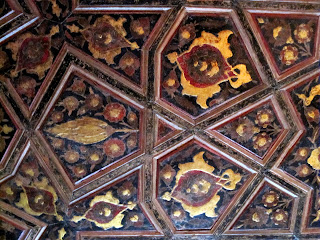The Rustem Pasha Mosque in Istanbul, Turkey,
is not too far from the Spice Market, built over a complex of shops. It was built from about 1561 to 1563. It was designed by Mimar Sinan, the chief architect for the sultans Suleiman the Magnificient, Selim II and Murad III. It was built to honor Grand Vizier (minister of the sultan) Damat Rustem Pasha, husband of Princess Mihrimah, one of the daughters of Suleiman the Magnificent, who died in July 1561. It is a very small mosque, but well-known because of the use of a large quantity of Iznik tiles in its construction, on both the exterior and interior. Iznik tile was made from the last quarter of the 1400s to the end of the 1600s in Iznik, western Anatolia, previously known as Nicea, where the Nicene Creed was promulgated. The original Iznik tiles were a cobalt blue, using Ottoman arabesque patterns with Chinese elements. During the 1500s additional colors were introduced. Turquoise was combined with a dark shade of cobalt blue, then sage green and pale purple were added. In the mid-1500s an iron-rich red replaced the purple and emerald green replaced the sage green.
One main dome
rests on four semi-domes in the diagonals of the building.
It has one minaret. It was difficult to find on our own, down some narrow (scary) alleys and up some non-obvious stairs. We had it all to ourselves, other than one worshiper who was kneeling before the mihrab. As in other mosques, we had to take off our shoes and Judy had to cover her hair with a scarf. I thought she looked very nice in it!
As in other mosques, I loved the beautiful, plush, carpet.


















You under-report the scary back alleyways that we traversed trying to find an entrance, which was very difficult to find. However, you are right about how stunningly beautiful the interior is. The smaller size, intimate feel, and incredible array of tile made this mosque a five-star experience.
ReplyDelete